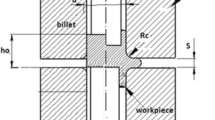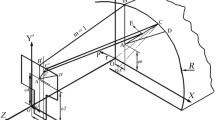Abstract
One of the substantial topics in the forward extrusion process is using theoretical methods to predict the exit profile distortion due to the non-symmetry of sections or the off-centricity of die cavity. In this paper, a new approach based on the Riemann mapping theorem and upper bound method is developed to obtain the velocity field and the strain distribution. Then, the strain distribution is determined for the die with off-centered square sections. Afterwards, the exit profile curvature is calculated using an approach based on elastic–plastic bending of beams. Theoretical results are compared to the results yielded through experimental and finite element simulation and validated. Subsequently, the effect of various parameters such as relative die length and friction factor is examined on the amount of the exit profile distortion. The results show that the obtained theory can be used to predict the strain distribution and the exit profile distortion in addition to the process pressure.

















Similar content being viewed by others
Abbreviations
- Bz, Dz :
-
Arbitrary curve boundary and its area
- Bw, Dw :
-
Unite circle boundary and its area
- E:
-
Elastic modulus
- J:
-
Total power consumption
- K:
-
Strength coefficient
- Kxz, Kyz :
-
Exit profile curvature in XZ and YZ planes
- L:
-
Die length
- L/R:
-
Relative die length
- M(u,q,t):
-
Function defining the velocity in the z direction
- Pave :
-
Average extrusion pressure
- R:
-
Radius of the billet
- T:
-
Time
- Wi :
-
Power due to internal deformation
- Wx :
-
Power due to exit surface of velocity discontinuities
- We :
-
Power due to entry surface of velocity discontinuities
- Wf :
-
Power due to die–material interface friction
- a:
-
Half of the square length
- e1, e2 :
-
Off-centric positions in x and y directions
- f(z):
-
Mapping power series
- f, g, h:
-
Functions of u, q, and t, which representing position of control points in Cartesian coordinates
- m:
-
Frictional factor
- n:
-
Strain hardening exponent
- u, q, t:
-
Dimensionless Parameters changing between 0 and 1
- ye :
-
Distance of the yield point to the neutral axis
- \(\varepsilon_{e}\) :
-
Strain at the yield point
- \({\dot{\upvarepsilon }}_{\text{ij }}\) :
-
Components of strain rate
- \(\varepsilon_{\text{x}}\), \(\varepsilon_{\text{y}}\), \(\varepsilon_{\text{z}}\) :
-
Strain components
- \(\vartheta\) :
-
Poisson ratio
- \(\rho\) :
-
Density
- \(\rho_{{f,{\text{xz}}}}\), \(\rho_{{f,{\text{yz}}}}\) :
-
Final radius of profile curvature
References
Yang DY, Lee CH (1978) Analysis of three-dimensional extrusion of sections through curved dies by conformal transformation. Int J Mech Sci 20(9):541–552. https://doi.org/10.1016/0020-7403(78)90012-7
Yang DY, Lange K (1984) Analysis of hydrofilm extrusion of three-dimensional shapes from round billets. Int J Mech Sci 26(1):1–19. https://doi.org/10.1016/0020-7403(84)90037-7
Boer C, Schneider W, Eliasson B, Avitzur B (1980) An upper bound approach for the direct drawing of square section rod from round bar. In: Proceedings of the twentieth international machine tool design and research conference, Springer, pp 149–156. https://doi.org/10.1007/978-1-349-05172-4_17
Gunasekera J, Hoshino S, Brown R (1980) Extrusion of non-circular sections through shaped dies. CIRP Ann 29(1):141–145. https://doi.org/10.1016/S0007-8506(07)61310-9
Chitkara N, Abrinia K (1990) A generalised upper bound solution for three-dimensional extrusion of shaped sections using Cad-Cam bilinear surface dies. In: Proceedings of the twenty-eighth international, Springer, pp. 417–424. https://doi.org/10.1007/978-1-349-10890-9_57
Celik K, Chitkara N (2000) Application of an upper bound method to off-centric extrusion of square sections, analysis and experiments. Int J Mech Sci 42(2):321–345. https://doi.org/10.1016/S0020-7403(98)00131-3
Qi HY, Wang SX, Zhu HJ (2006) Similar extrusion and mapping optimization of die cavity modeling for special-shaped products. Trans Nonferrous Met Soc China 16(3):587–592. https://doi.org/10.1016/S1003-6326(06)60103-9
Hongyuan Q, Keshan C, Wanhua S, Hengjun Z (2007) Vertical curve analysis of extruding die cavity and conformal mapping. J Rare Earths 25:375–378. https://doi.org/10.1016/S1002-0721(07)60509-2
Ajiboye J, Adeyemi M (2007) Upper bound analysis for extrusion at various die land lengths and shaped profiles. Int J Mech Sci 49(3):335–351. https://doi.org/10.1016/j.ijmecsci.2006.08.017
Assempour A, Hassannejadasl A (2009) Minimization of the exit profile curvature in non-symmetric T-shaped sections in the extrusion process. Mater Des 30(4):1350–1355. https://doi.org/10.1016/j.matdes.2008.06.038
Abrinia K, Davarzani H (2012) A universal formulation for the extrusion of sections with no axis of symmetry. J Mater Process Technol 212(6):1355–1366. https://doi.org/10.1016/j.jmatprotec.2012.01.015
Gordon W, Van Tyne C, Moon Y (2012) Minimizing distortion during extrusion using adaptable dies. Int J Mech Sci 62(1):1–17. https://doi.org/10.1016/j.ijmecsci.2012.05.006
Gordon W, Van Tyne C, Moon Y (2013) Adaptable dies to minimize distortion in non-axisymmetric extrusions. Int J Mech Sci 77:65–81. https://doi.org/10.1016/j.ijmecsci.2013.09.008
Abrinia K, Ghorbani M (2012) Theoretical and experimental analyses for the forward extrusion of nonsymmetric sections. Mater Manuf Processes 27(4):420–429. https://doi.org/10.1080/10426914.2011.577869
Karami K, Abrinia K (2014) An analytical formulation as an alternative to FEM software giving strain and stress distributions for the three-dimensional solution of extrusion problems. Int J Adv Manuf Technol 71(1–4):653–665. https://doi.org/10.1007/s00170-013-5500-1%20
Abrinia K, Farahmand P, Parchami-Sarghin M (2014) Formulation of a new generalized kinematically admissible velocity field with a variable axial component for the forward extrusion of shaped sections. Int J Adv Manuf Technol 70(5–8):1427–1435. https://doi.org/10.1007/s00170-013-5365-3
Das R, Sarmah A, Lakshmi D, Sood A (2014) A finite element analysis on the effect of location of holes, die pockets and extrusion speed in multi-hole extrusion process. Proc Eng 97:1247–1253. https://doi.org/10.1016/j.proeng.2014.12.403
Onlaghi SN, Assempour A (2015) On the minimization of the exit profile curvature in extrusion through multi-hole dies: a methodology and some verifications. Meccanica 50(5):1249–1261. https://doi.org/10.1007/s11012-014-0080-1
Tabatabaei SA, Abrinia K, Tabatabaei SM, Shahabadi M, Besharati MK (2015) Analytical modeling of the extrusion process using the electrostatics concept. Mech Mater 88:87–102. https://doi.org/10.1016/j.mechmat.2015.03.007
Parghazeh A, Haghighat H (2016) Prediction of central bursting defects in rod extrusion process with upper bound analysis method. Trans Nonferrous Met Soc China 26(11):2892–2899. https://doi.org/10.1016/S1003-6326(16)64418-7
Zhou W, Lin J, Dean TA, Wang L (2018) Feasibility studies of a novel extrusion process for curved profiles: experimentation and modelling. Int J Mach Tools Manuf 126:27–43. https://doi.org/10.1016/j.ijmachtools.2017.12.001
Sheikhpour M (2012) Forward extrusion bearing design using upper bound. Dissertation, University of Tehran. https://thesis2.ut.ac.ir/thesisinfo/ThesisPdf15PagesFiles/2013-12/261316-15Page-.pdf
Louhghalam A, Igusa T, Park C, Choi S, Kim K (2011) Analysis of stress concentrations in plates with rectangular openings by a combined conformal mapping–finite element approach. Int J Solids Struct 48(13):1991–2004. https://doi.org/10.1016/j.ijsolstr.2011.03.005
Liang NW, Lai CH, Hsu CY, Chiang YC, Chang CC, Chen SL (2014) A conformal-mapping method for predicting the thermal properties of U-shaped borehole heat-exchangers. Geothermics 50:66–75. https://doi.org/10.1016/j.geothermics.2013.08.006
Sahraei S (2018) Computation of plane potential flow past multi-element airfoils using conformal mapping, Dissertation, Wichita State University. https://soar.wichita.edu/bitstream/handle/10057/15424/d18021_Sahraei.pdf?sequence=1&isAllowed=y
Planche T, Jung PM, Saminathan S, Baartman R, Basso MJ (2019) Conformal mapping approach to dipole shim design. Nucl Instrum Methods Phys Res Sect A 925:101–105. https://doi.org/10.1016/j.nima.2019.01.038
Schinzinger R, Laura PA (2003) Conformal mapping: methods and applications. Courier Corporation, Mineola
El Megharbel A, El Nasser G, El Domiaty A (2008) Bending of tube and section made of strain-hardening materials. J Mater Process Technol 203(1–3):372–380. https://doi.org/10.1016/j.jmatprotec.2007.10.078
Funding
This study was funded by Babol Noshirvani University of Technology (grant number BNUT/370203/97).
Author information
Authors and Affiliations
Corresponding author
Ethics declarations
Conflict of interest
The authors declare that there is no conflict of interests regarding the publication of this paper.
Additional information
Publisher's Note
Springer Nature remains neutral with regard to jurisdictional claims in published maps and institutional affiliations.
Rights and permissions
About this article
Cite this article
Sheikhpour, M., Hosseinipour, S.J. & Mirnia, M.J. Prediction of exit profile distortion in forward extrusion process using Riemann mapping theorem and upper bound method. Meccanica 55, 1099–1118 (2020). https://doi.org/10.1007/s11012-020-01141-1
Received:
Accepted:
Published:
Issue Date:
DOI: https://doi.org/10.1007/s11012-020-01141-1




